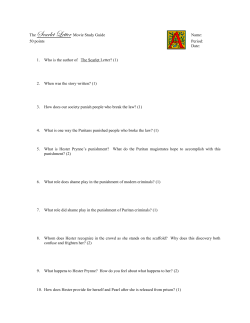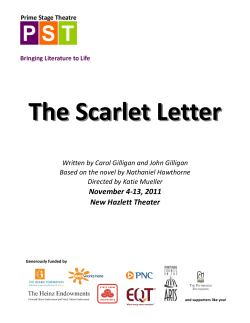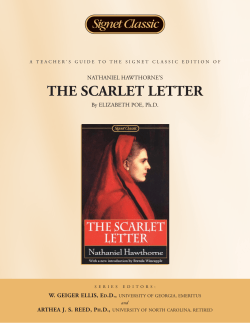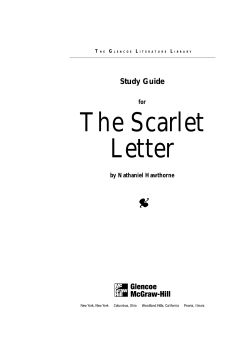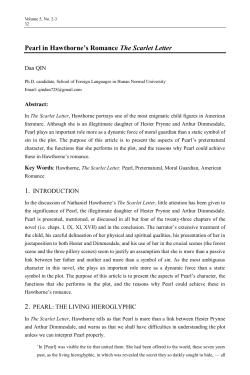
Public Confession and The Scarlet Letter Author(s): Ernest W. Baughman Reviewed work(s): Source:
Public Confession and The Scarlet Letter Author(s): Ernest W. Baughman Reviewed work(s): Source: The New England Quarterly, Vol. 40, No. 4 (Dec., 1967), pp. 532-550 Published by: The New England Quarterly, Inc. Stable URL: http://www.jstor.org/stable/363557 . Accessed: 29/01/2013 11:30 Your use of the JSTOR archive indicates your acceptance of the Terms & Conditions of Use, available at . http://www.jstor.org/page/info/about/policies/terms.jsp . JSTOR is a not-for-profit service that helps scholars, researchers, and students discover, use, and build upon a wide range of content in a trusted digital archive. We use information technology and tools to increase productivity and facilitate new forms of scholarship. For more information about JSTOR, please contact support@jstor.org. . The New England Quarterly, Inc. is collaborating with JSTOR to digitize, preserve and extend access to The New England Quarterly. http://www.jstor.org This content downloaded on Tue, 29 Jan 2013 11:30:24 AM All use subject to JSTOR Terms and Conditions PUBLIC CONFESSION AND THE SCARLET LETTER ERNEST W. BAUGHMAN IN The ScarletLetter,Dimmesdale'sstoryendswiththepub- lic confessionof his sin, the acknowledgement of Hester as his partner,and the recognitionof Pearl as his child. The confessionknitsup the storystrandsof the fourmajor characters;and it furtheraffectsthe lives of the remainingcharacters.The psychologicalnecessityforDimmesdale'sconfession has been establishedbeyonddoubt long beforeit occurs. As the authorhas managedthe plot,no otherendingis possible. However, Hester's treatmentby colony and church authoritiesin the firstpilloryscene impliesthatpublic confessionwas customary forcertaincrimesin Massachusetts Bay Colony,and it suggeststhatHawthornemayhave been using a historicalas well as psychologicaland dramaticnecessity.If sucha traditionexisted,thenoveltakeson an added dimension of fidelityto seventeenth-century theology,ethics,and law. If the traditionof public confessionhad a broaderbase than MassachusettsBay between 1642 and 1649 (the time of the story),thisdimensionbecomesevenmoreimportantand adds greatlyto themeaningsof theactionsof themajor characters. The questions,then,are these.What was Puritanpracticeregardingpublic confessionat the timeof The ScarletLetter? What authorityforit existedin churchdiscipline,traditional or written?Did it have a scripturalbasis?Did it have legal as Had it been taken over from well as churchenforcement? it or had been PlymouthColony, developedbecausesomekind was after of discipline necessary leaving Anglican formsbehind?Did it have Englishroots?And was a personexpectedto confesssecretcrimesor sins to civil or churchauthorities?If we can findanswersto thesequestions,we shall be betterable Dimmesdale'sneed forconfessionand we shall be to interpret of his confession moreable to place in perspectivethe effects on Hester,Pearl,and Chillingworth. Literaryevidenceforrequiredpublic confessionis scant.In 532 This content downloaded on Tue, 29 Jan 2013 11:30:24 AM All use subject to JSTOR Terms and Conditions THE SCARLET LETTER 533 thenovelbothcolonyand churchofficers urge Hesterto confess.And Dimmesdaleand Chillingworth argueaboutwhether one mustconfessan unknownsin duringhis lifetime.'Samuel Sewall's Diary recordsthat in January1696/7he publicly trials.Sewall'sconconfessedhiserrorsin theSalemwitchcraft fession,like Dimmesdale's,was voluntary;however it occurredabout fifty yearsafterDimmesdale's;and it was a confessionoferror,not ofa crime. As a matterof record,public confessionwas required by both churchand statefora varietyof sins and crimesin the MassachusettsBay Colony fromthe verybeginning,in the PlymouthColonyat leastas earlyas 1624,and-more surprising-in VirginiathirtyyearsbeforeHester'shumiliationon ofall to thosewho have depended thepillory.Mostsurprising on literarysourcesforour history, thePuritans,the Pilgrims, and the Virginiansweresimplycontinuinga traditionas old as the England of Elizabeth (and fornotoriouscrimeseven older). Not only is the traditionold, it continuedin fairly commonuse in New Englandintothenineteenthcenturyand in Scotlanduntil fairlylate in thatcentury.It is still in use todayin somedenominationsin thiscountry.2 A noteworthy featureoftheEnglishtraditionis thatpunishmentforcivil crimeoften(as in America) included confession of thecrimein church.A. H. A. Hamiltonreportsof the age of Elizabeth: "A favouritepunishmentforsmall offenses, had suchas resistinga constable,was thestocks.The offender to comeintothechurchat morningprayer,and saythathe was sorry,and was thenset in the stocksuntil the end of evening prayer."3He reportsthe same practiceduring the reign of 1 Nathaniel Hawthorne, The Scarlet Letter,The CentenaryEdition (Columbus, Ohio, 1962), 131-137. Subsequent citations to this edition will be in parenthesesfollowingthe quotations. 2 Alice Morse Earle, Curious Punishmentsof Bygone Days (New York, 1909), io6-1o8, 111-112. Her earliest case is 1534, her latest 1884, fromScotland. See also Charles Francis Adams, Jr.,"Some Phases of Sexual Morality and Church Discipline in Colonial New England," Proceedings of the Massachusetts Historical Society,Second Series (1890-1891), VI, 493. I know of similar cases in Indiana between 1934 and 1944. 3 A. H. A. Hamilton, Quarter SessionsfromQueen Elizabeth to Queen Anne: Illustrationsof Local Governmentand History Drawn from Original Records (Chieflyfromthe County of Devon) (London, 1878), 31-32,86. This content downloaded on Tue, 29 Jan 2013 11:30:24 AM All use subject to JSTOR Terms and Conditions 534 THE NEW ENGLAND QUARTERLY JamesI. In 1776 one JamesBeadwell was sentencedto do penance at Stokesbychurchin the followingway: "In the timeofDivine service,betweenthehoursoftenand elevenin the forenoonof the same day, in the presenceof the whole congregationassembled,being barehead,barefootand barelegged,having a white sheet wrapped about him fromthe shoulderto the feetand a whitewand in his hand,whereimmediatelyafterthereadingoftheGospel,he shall standupon some formor seat before the pulpit or place where the minister readeth prayersand say afterhim as forthwith,etc."4 Typi- was requiredwereimmorality, cal crimesforwhichconfession defamation of character, disregardof the Sabbath, cheating, and heresy.5 Of the Protestantconfessionsof faithin Great Britainbefore1630,onlytheScotchConfessionofFaithof 1560required Confessionof 1647alpublic avowalofsin.6The Westminster lows eitherprivateor public confession.7 Andrew Edgar's Old Church Life in Scotland describes four Scottishcases between1671 and 1788: two forirregularmarriagesso thatthe childrencould be christened,one foroverchargingforservices,and one to regularizean irregularmarriage(thatofRobertBurnsand JeanArmour)." The Americantraditionhad itsbeginningsat leastby 1611. The LavvesDiuine, Morall and Martiall,etc.,promulgatedby Sir Thomas Dale as governorof Virginia,containsfouritems forwhichpartof the punishmentwas confesslistingoffenses or includederidingthe scriptures offenses church. The in ing ministers,detracting,slandering,calumniating,murmuring, disobeying,or neglectingthecommands resisting, mutinying, For refusingto repairto theministerforreofcolonyofficers. one would be treatedthus: instruction, ligious 4 Earle, 107-108. 5 Hamilton, 32. 6 Philip Schaff,editor,The Creeds of Christendom(New York, 1919), III, 474. 7 Schaff,632-633. 8 Andrew Edgar, Old Church Life in Scotland: Lectures on Kirk-Sessionand PresbyteryRecords,Second Series (London, 1886), 183, 199, 224, 227. This content downloaded on Tue, 29 Jan 2013 11:30:24 AM All use subject to JSTOR Terms and Conditions THE SCARLET LETTER 535 The Gouernour shall cause the offenderfor his firsttime of refusall to be whipt,forthe second time to be whipt twice,and to acknowledgehis faultvpon the Saboth day,in the assemblyof the and forthethirdtimeto be whipteueryday untilhe congregation, hathmade thesame acknowledgement, and asked forgiuenessefor the same, and shall repaire vnto the Minister,to be furtherinstructedas aforesaid.9 That some of the penalties were enforced is made clear by the following parish records related by Bishop William Meade: In examiningthe early historyof Hungar's Parish, we find that in the year 1633 the offenseof slanderingthe firstminister,the Rev. Mr. Cotton,was punished in the followingmanner:-"Ordered by thecourtthatMr. HenryCharltonmake a pair of stocks and set in themseveral Sabbath-daysduring divine service,and thenask Mr. Cotton'sforgiveness, forusing offensiveand slanderous wordsconcerninghim."10 Parenthetically,Hester Prynne might not have fared any betterin Virginia than in Boston, forBishop Meade notes, "I find that, for the violation of the seventh and ninth commandments.., the most frequentand disgracefulpunishmentswere inflicted.'"" The firstNew England account I have found is from 1624. One John Lyfordof Plymouth confessedthathe had sent lying lettersto the company officialsin London and that he had used intemperatespeech during his trial.12 The most abundant evidence forNew England practice and for the overlapping of civil and church punishments between 9 For the Colony of VirgineaBrittania. Lavves Diuine, Morall and Martiall, etc. (London, 1612), reprintedby Peter Force, editor, Tracts and Other Papers Relating Principally to the Origin, Settlementand Progress of the Colonies of North America from the Discovery of the Country to the Year 177i (New York, 1947), 1I, Tract No. 2, 17-18. 10William Meade, Old Churches,Ministersand Families of Virginia (Phila- delphia, 1872), I, 254. 11 Meade, I, 254. 12William Bradford,History of Plymouth Plantation, W. C. Ford, editor (Boston, 1912), I, 397- This content downloaded on Tue, 29 Jan 2013 11:30:24 AM All use subject to JSTOR Terms and Conditions 536 THE NEW ENGLAND QUARTERLY 1630 and 1650 comes from John Winthrop's Journals.13An account of 1640 presents a situation somewhat relevant to Dimmesdale's. Captain Underhill, like Dimmesdale guilty of adultery, returned to Boston after a long struggle with his conscience during his excommunication and banishment. had broken his The Lord aftera long time and great afflictions, him and to humble himself heart, brought night and day with and till his was tears wasted; and indeed he apstrength prayers a man worn with as out sorrow,and yethe could findno peared therefore he now was come to seek it in this ordinance of peace, God. (Winthrop,11,12-14,September3, 1640) The Journals describe sixteen such cases handled by the courts, the church, or both. Adultery is central in four, contemptforauthorityin four,suspicion of heresyin two. Heresy, assault, overcharging for goods, disorderly conduct, and violent language appear in single cases. The accused make public confessionsin all cases. The insistence on public confession is inescapable in these accounts; however, the procedures and the lines of authoritybetween the civil and church actions are vague. Some generalizations about these matters will appear later. Because both the courts and the churches required public confession,we should expect to findstatutesand church rules making the practice official.I have found no such statute; however, The Court of Assistantsspecifiedeight such penalties between 1632 and 1644.14 Because this court had both judicial and legislative functions, a decision was quite probably the equivalent of a law. Church usage was regularized in the firstprinted discipline in New England. The Platformof Church Discipline appeared in 1648, one year afterthe adoption in England of the WestminsterConfession. It differsfromthe English model in that it 13John Winthrop, Winthrop's Journals, James K. Hosmer, editor (New York, 1908). Several of Winthrop's cases will be quoted below with citations in parentheses. 14Records of the Court of Assistantsof the Colony of the MassachusettsBay 163o-1692(Boston, 1904, 1928), II, 24, 65, 92-93,131; III, 74-75, 137- This content downloaded on Tue, 29 Jan 2013 11:30:24 AM All use subject to JSTOR Terms and Conditions THE SCARLET LETTER 537 specifiespublic confession. We can assume that it regularizes the practices that had existed in the Colony from the beginning. The following excerpts are from Chapter XIV "Of excommunication 8c other Censures." (I have modernized the spelling.) [For privateoffenses(betweenbrotherand brother)if the offender]hear the churchand declare the same by penitentconfession he is recoveredand gained; and if the churchdiscernhim to as in case be willingto hear,yetnot fullyconvincedof his offense, to him of heresy;They are dispenseto a public admonition;which to lie underthepublic offenseof thechurch, declaringtheoffender doth therebywithholdor suspend him fromthe holy fellowship of the Lord's Supper, till his offensebe removedby penitentconfession.If he stillcontinueobstinate,theyare to cast him out by excommunication. 2 3 But if the offensebe more public at first,and of a more heinous and criminalnature,to wit, such as are condemned by the light of nature; then the churchwithout such gradual proceeding,is to cast out the offender,fromtheirholy communion, for the furthermortifying of his sin and the healing of his soul, in theday of theLord Jesus. so as by the 7 If the Lord sanctifythe censureto the offender, grace of Christ,he doth testifyhis repentance,with humble confessionof his sin, and judging of himself,givinggloryunto God; the Church is then to forgivehim and to comforthim, and to restorehim to the wontedbrotherlycommunion,which formerly he enjoyedwiththem.15 The capital crime of adultery of Hester and Dimmesdale would come under Paragraphs 3 and 7 of the above regulations. Other cases of public confession in New England are to be found in the records of the Court of Assistants,the writingsof Joseph Barlow Felt, Charles Francis Adams, Jr., and Haw15 A Platform of Church Discipline ... Agreed upon by the Elders ... of the Church Assembled at Cambridge in New England. Reprinted by Williston Walker, editor, The Creeds and Platforms of Congregationalism(New York, 1962), 227-228. For the Westminster Confession see Schaff, 1i, 632-633- This content downloaded on Tue, 29 Jan 2013 11:30:24 AM All use subject to JSTOR Terms and Conditions 538 THE NEW ENGLAND QUARTERLY thorne himself.16Of these, it is necessary to comment on the thirtycases from South Braintree (later Quincy) given by Charles Francis Adams for the light they shed on Pearl's religious status in the novel. Adams discovered that eighteen of the cases were confessions of fornication before marriage by couples then married and the parents of a child. He surmised that the confessionwas to clear the way for the baptism of the child. The following minute fromthe Groton church records corroborated his surmise of the existence of a "seven-months' rule." June 1, 1765. The Church then voted with regard to Baptizing childrenof personsnewlymarried,That those parentsthat have not a child till seven yearlymonthsafterMarriage are subjects of our Christian Charity,and . . . shall have the privilege of Baptism for their Infantswithout being questioned as to their Honesty.l7 This rule of the Groton church continued in effectuntil 1803Adams' comments on the rule provide a definite basis for Pearl's outcast state and for understanding Hester's and Dimmesdale's parts in it. With the churchrefusingbaptismon the one side and with an eternityof tormentforunbaptisedinfantson theother,some definite line had to be drawn. This was effectedthroughwhat was knownas "the seven-months' rule"; and the penaltyforits violation, enforcedand made effectiveby the refusalof the rites of baptism,was a public confession.18 Though the Adams cases are largely fromthe eighteenth century,several cases tried by the Court of Assistantsindicate that the same practices were followed in the seventeenthcentury. Before analyzing the importance of the practice of public confessionin the novel, we should make what generalizations 16Adams, 477-516.Joseph Barlow Felt, The Annals of Salem (Salem, 1849), II, 459-460,535, 587. Nathaniel Hawthorne, The American Notebooks, Randall Stewart,editor (New Haven, 1932), 276-280.The cases were recorded in 1852. 17 Adams, 494. 18Adams, 495. For Scottishcases of withholding baptism in 1671 and 1694, see Edgar, 183, 224. This content downloaded on Tue, 29 Jan 2013 11:30:24 AM All use subject to JSTOR Terms and Conditions THE SCARLET LETTER 539 seem warrantable. (1) In most cases of the early seventeenth century, the court dealt with the offenderfirst;it might or might not require public acknowledgement of error by the offender.(2) Afterthe court had passed sentence,the congregation heard the evidence and dealt with the offender,determining whether to accept his confession or to cast him out. (3) Afterconfessingin church,a member guiltyof a civil or criminal offensewas required to stand trial. He could be executed. He could not confess privately and receive absolution as an Anglican or Catholic could. (4) An erring member brought before the congregation for specific misconduct or suspected misconduct might be dealt with in four ways: he could be admonished to mend his ways; he could be suspended from participation in the Lord's Supper; he could be excommunicated; or he could be cleared either if he confessed or if adjudged innocent. (5) Confession was mandatory if one suspended fromthe privilege of the Lord's Supper or one excommunicated wished to be received back into the church. (6) Apparently confession was mandatory for all parents guilty of fornicationbefore marriage if theywere church members or if theylater applied forchurch membership (the "seven-months' rule" affected both groups). (7) The dual jurisdiction of church and court was common in England and Scotland long before the seventeenthcentury; it was common in Massachusettsand Virginia during the seventeenthcentury. Hawthorne could easily have known of the Puritan emphasis on public confession from various sources including oral tradition.19The emphasis on public confessionin the accounts given above helps us understand the importance of confession forDimmesdale, Hester, and Pearl. Confession is more than a 19See referencesin Notes 14 and 16 above; add Charles Boewe and Murray G. Murphey,"Hester Prynnein History,"American Literature,xxxII, 202-204 (May, 1960). M. L. KesselringreportsHawthorne's familiaritywith Winthrop's Journals and Felt's Annals in "Hawthorne's Reading," Bulletin of the New York Public Library, LIII, 55-71, 121-138, 173-194 (1949). Vernon Loggins gives Salem court records for sentences passed on three of Hawthorne's collateral kinsmen (the firstJohn Hathorne for forgery,and two Manning sisters for incest). The Hawthornes (New York, 1951), 42, 89. Felt describes the incident but does not identifythe women. Annals, 11,459-460. This content downloaded on Tue, 29 Jan 2013 11:30:24 AM All use subject to JSTOR Terms and Conditions 540 THE NEW ENGLAND QUARTERLY used plotdevice: it is basic to thefabricof thenovel skillfully becauseit is an essentialofchurchdisciplineand civillaw. On a purelysociallevel,it is themeansbywhichan individualcan remaina partof society:lackingconfession,the sinnerceases to be a partofthatsociety,or he is so muchat oddswithit that his functioningis seriouslyimpaired.Confessionis, in Hawthorne'swords, "The proof and consequence" of repentance. (66) Because Hawthorneuses Dimmesdale'sconfessionfor the considerhis denouementof The ScarletLetter,we shouldfirst in His the Puritan of being led to tradition. problem light confessionis the problemof the novel, the one dramatized; and becauseof thetimeand theplace, theconfessionmustbe a public one. Dimmesdale'sguilt is knownonly to Hester and Chillingworth,neitherof whomwill discloseit. His defensefornot is his contentionthatpublic confessionofsin is not confessing requiredby Holy Writ; he also arguesthathis capacityto do good (by servingGod as a minister)would be lost if his guilt were known.He almostcertainlyknowsthathis positionis confessionofsecret false.Though theauthorityformandatory sin is lessclear thanthatforknownsin,he has no groundsfor a distinctionbetweensecretand knownsin.20Sin is sin and mustbe confessed.The Puritanstook quite seriouslythe admonitionof James:"Confessyourfaultsto one another,and prayforone another,thatye may be healed." (James5:1 6.) Dimmesdaleis too weak to do what he knowsis requiredof him. Today we would say that he rationalized;Hawthorne indeed,ofescapingfromanytopicthat said,"He had a faculty, and nervoustemperament."(133) his sensitive too agitated The fulleststatementof his defensein the novel is addressed to Chillingworth: There can be . .. no power,shortof Divine mercy,to disclose, whether byutteredwords,or by typeor emblem,thesecretsthat witha humanheart.The heart,makingitselfguilty buried be may 2o0James Brittonconfessedvoluntarilyto guilt of adulteryand was executed with his partner Mary Latham. Winthrop,In, 161-163 (March, 1644). This content downloaded on Tue, 29 Jan 2013 11:30:24 AM All use subject to JSTOR Terms and Conditions THE SCARLET LETTER 541 of such secrets,must perforcehold them,until the day when all hidden thingsshall be revealed.Nor have I so read or interpreted Holy Writ,as to understandthatthedisclosureof human thoughts and deeds, then to be made, is intendedas a part of the retribution.(131) A little later in the same interview,pressed to reveal the source of his sickness of soul, he makes an impassioned refusal and rushes fromthe room: Nol-not to theel-not to an earthlyphysician. .. Not to thee! But, if it be the soul's disease,thendo I commitmyselfto the one Physicianof the soul! He, if it stand with his good pleasure,can cure; or he can kill! Let him do with me as, in his justice and wisdom,he shall see good. But who art thou, that meddlestin this matter?-thatdares thrusthimselfbetween the suffererand his God? Dimmesdale could have made such statementsto no one but Chillingworth (or Hester). "Thrusting oneself between the suffererand his God" is exactly what a good Puritan was expected to do. Nevertheless he holds to his position until he is able to make the confession.During the seven years of silence he adds the sin of hypocrisy:in his sermons,in his plans to flee with Hester, and in refusing to admit that anyone besides Chillingworth has violated the sanctityof a human heart. If we can assume that Dimmesdale completely believes his position on confession (though if he did, he would have no problem; and there would be no novel), we may ask whether he is culpable in any other actions. One that should immediately come to mind is his complete disregard for the state of Hester's soul-or Pearl's-until the very end of his life. The words of Governor Bellingham remind us of this unconcern: "... the responsibilityof this woman's soul lies greatlywith you. It behooves you, therefore,to exhort her to repentance, and to confession,as a proof and consequence thereof." A second source of culpability is Dimmesdale's receiving and administering the Lord's Supper during the seven-year hypocrisy.The main requirement of one engaging in the rite This content downloaded on Tue, 29 Jan 2013 11:30:24 AM All use subject to JSTOR Terms and Conditions 542 THE NEW ENGLAND QUARTERLY is that he be trulyrepentant. St. Paul is unequivocal: "Wherefore whosoever shall eat this bread, and drink this cup of the Lord unworthily,shall be guilty of the body and blood of the Lord. But let a man examine himself,and so let him eat of that bread and drink of that cup. For he that eateth and drinketh unworthily,eateth and drinkethdamnation to himself,not discerning the Lord's body." (I Corinthians 12:27-29.) Dimmesdale has to know that he is unworthyof receiving the sacrament; he is probably even less worthy of administering the rite. He is guilty of a capital crime according to both colony and scripturallaw. He has not made his "confession as a proof and consequence" of repentance. Though he resolved to repent many times, as the chapter "The Interior of A Heart" attests,he could not. Several of Winthrop's cases shed light on Dimmesdale's problem: cases in which the confession is voluntary. That of Mr. Batchellor suggests Dimmesdale's problem with the Lord's Supper. A minister, he had attempted adultery with a parishioner and had slandered her when she accused him. "But soon after,when the Lord's Supper was to be administered, he did voluntarily confessthe attempt,and thathe did intend to have defiledher." (Winthrop, II, 45-46, November 12, 1641.) The weight of unconfessed sin is evident in three similar cases in which secret confessionto God has been fruitless.21The case of one Turner who committedsuicide because he could not bring himself to confessis perhaps applicable to Dimmesdale's situation. (Winthrop, II, 55, January 1642.) The whole chapter "The Minister in a Maze" indicates that he must do something desperate if he does not soon findrelease in confession. Perhaps the most applicable case, afterall, is that of Judge Sewall who rose to a tragic triumph when he confessed his errorsin the witchcrafttrials.The weight of tradition in both church and state demanded public confession.Hawthorne put the decision squarely where he wanted it to rest: on the conscience of the guilty man. No outside agency forced it. When it finallycame, it was complete and genuine. Gone were the 21 Winthrop,nI,12-14,29, 161-163. This content downloaded on Tue, 29 Jan 2013 11:30:24 AM All use subject to JSTOR Terms and Conditions THE SCARLET LETTER 543 rationalizations about his usefulness as a minister and his insistence that Chillingworth's crime was greater than that of Hester and himself.In fact,he acknowledged theirguilt in the same terms he had earlier used to describe Chillingworth's crime. "It may be, that, when we forgotour God,-when we violated our reverenceeach for the other'ssoul,-it was thenceforthvain to hope thatwe could meet hereafter,in an everlasting and pure reunion. God knows; and he is merciful!"22He asked for nothing but God's mercy,indicating the condition of the true penitent. As the plot is handled there can be only one solution. If Dimmesdale had confessed privately,to the Rev. John Wilson forexample, he would need to confesspublicly; he would be excommunicated, and he would stand trial for the crime of adultery. He could have been executed as Mary Latham and James Britton were in 1644. Although Hawthorne once considered having Dimmesdale confess to a Catholic priest, the difficultiesof this ending are so obvious that we hardly need consider his rejection of it, though he was later able to use a somewhat similar confession in The Marble Faun.23 Although Hester's problem of repentance is differentfrom Dimmesdale's, it must be examined in the same context. The same rules of public confession apply to women as to men in seventeenth-centuryMassachusetts. A possible prototype of Hester had confessed in court in Salem in 1668.24 The changes in Hester that seem to be most emphasized by Hawthorne (and by modern readers) are her improving reputation and her growing speculative tendency; however, the author also holds constantly before the reader the unsatisfactorystate of her soul and her need for repentance. At her firstappearance in the book, Governor Bellingham addresses the minister: "Good Master Dimmesdale ... the responsibilityof this woman's soul lies greatlywith you. It behooves you, 22 Italics mine. For the importance of violating the reverence for another's soul, see James E. Miller, Jr.,"Hawthorne and Melville: The Unpar- donable Sin," PMLA, LXX, 91-114 (March, 1955). 23 James Russell Lowell, Letters, C. E. Norton, editor (1894), I, 302. 24 Boewe and Murphey. This content downloaded on Tue, 29 Jan 2013 11:30:24 AM All use subject to JSTOR Terms and Conditions 544 THE NEW ENGLAND QUARTERLY to exhorther to repentance,and to confession,as therefore, a proof and consequence thereof."AfterDimmesdale'sexRev. JohnWilsonaddressesHesterdirectly:"Womhortation, not beyondthe limitsof Heaven's mercy an, transgress .... the name! [of her partner]That, and thyrepentSpeak out ance, mayavail to take the scarletletteroffthybreast."She is urgedby a voice fromthe crowdto speak the name of her partnerand give her child a name. In her refusalto repent and confess,she acceptsthe sentenceof the scarletletterand all of itsresponsibilities: she refusesto giveherchild a name; of keeping Dimmesdale's and she accepts the responsibility secret.Most importantforherself,in refusingto repentand confess,sherefusesto be reunitedwiththechurch.She has cut herselfofffromGod. Though Hawthornehas not said so, she at thetimeofPearl'sbirth, would havebeen excommunicated or earlier.The ceremonycenteringon the pillory(oftenreferredto as "Hester'shumiliation")mustbe regardedas her She refusesbeto be reunitedwiththe church.25 opportunity would implicateDimmesdaleand because causeherconfession she hopessomehowfora lifewithhim at sometime. It is truethatHawthorneoftenspeaksambiguouslyabout her sin and of the results(the Madonna description,forexremindsthereaderthatshe is guilty ample); he also constantly in of a crimeand a sin,as thefollowinglines: "She knewthat that herdeed had been evil; shecould haveno faith,therefore, itsresultwouldbe forgood." In ChapterXIII, afterindicating her growing Hester'sgrowingacceptanceby the community, freedomin speculation,and the desperationdrivingher almostto themurderofPearl and to suicide,Hawthorne,speaking as theauthor,saysflatly:"The scarletletterhad not done itsoffice."Earlyin ChapterXV, the authorasks: "Had seven long years,under the tortureof the scarletletter,inflictedso and wroughtout no repentance?"Hawthorne, muchofmisery, as again speaking the author,uses twopages at the beginning 25 See Rudolph Van Abele, "The Scarlet Letter: A Reading," Accent, xI, 214 (1951). "The public scaffoldoffersthe opportunity,at least, for the offender to make his peace with societyin termsof punishment which has a personal ritual significanceforeverymember." This content downloaded on Tue, 29 Jan 2013 11:30:24 AM All use subject to JSTOR Terms and Conditions THE SCARLET LETTER 545 of Chapter XVIII, "A Flood of Sunshine," to elaborate unambiguously on her lack of change and to caution the reader about the proposed flightof the lovers-to point out, in effect, that she has become a temptressfor a second time. These authorial commentsdeserve examination: But HesterPrynne,with a mind of nativecourage and activity, and forso long a period not merelyestranged,but outlawed,from society,had habituated herselfto such latitude of speculation as was altogetherforeignto the clergyman.She had wandered,without rule or guidance, in a moral wilderness;as vast, as intricate and shadowyas theuntamedforest.... The tendencyof her fateand fortuneshad been to set her free. ... Shame,Despair, Solitude! These had been her teachers,-stern and wild ones,-and theyhad made her strong,but taught her much amiss. Thus, we seem to see that,as regardedHesterPrynne,thewhole seven yearsof outlaw and ignominyhad been little other than a preparationforthisveryhour. Here we findthe reason, alluded to once before,forher staying in Boston after her sentence when she might have removed elsewhere: she still loved Dimmesdale and hoped that somewhere at some time theymight have a life together.Admirable as this constancy is, it is not the way to repentance. The author's warning to the reader is unmistakable; the planned flightwill not occur. Nor will a change toward repentance or confession be possible to her as long as she conceals Dimmesdale's secret,or as long as she nourishes her hopes. (Her reputation has improved; but so has Dimmesdale's.) A change toward repentance is not discernible in Hester until after Dimmesdale's death; it is stronglyimplied in the last chapter. Hester, like Chillingworth and Dimmesdale, has violated the sanctityof the human heart, Hawthorne's unpardonable sin, though both lovers deny it in the forestwhile accusing Chillingworth. In concealing Dimmesdale's sin, she has taken a responsibilityforhis soul that could not possibly be justified in Puritan practice. Possibly it is this lapse, as much as the circumstancesof the adultery, that Dimmesdale had in mind This content downloaded on Tue, 29 Jan 2013 11:30:24 AM All use subject to JSTOR Terms and Conditions 546 THE NEW ENGLAND QUARTERLY when he answered her as we have noted earlier: "When we violated our reverence each for the other's soul. . . ." Her responsibilityto Pearl's soul will also have to be examined. To twentieth-century readers, Hester is the most attractive character in the novel; we are astonished at her strength;and we applaud her heroism in insisting on her own truth: that love transcendsall God- and man-made limits-the heroism of fallen angels. However, she is a Puritan, and her salvation (a state that fallen angels do not seek) must be found within the systemof Puritan belief and practice. She too must be led to repentance, not held up as the model of the "new woman." Here again the author speaks unambiguously: Hester had once had the giftsto become the new woman, "the destined prophetess." However, she "had long since recognized the impossibility that any mission of divine and mysterious truth should be confided to a woman stained with sin, bowed down with shame, or even burdened with a life-longsorrow." While he has shown an enormous sympathyfor Hester (and while he obviously sees the need for a new dispensation for womanhood), Hawthorne has been as consistent in his treatmentof Hester as he has been with that of Dimmesdale in working out her problem in accord with Puritan practices. He has not been as specificabout the working out of her destiny,but we have his word that she will achieve penitence. The change in Pearl is dependent on the changes in both Dimmesdale and Hester. Pearl must somehow lose her naturalunnatural wildness and her complete isolation from other human beings.26Hawthorne's statementof her change is brief and cryptic: Pearl kissed his lips. A spell was broken. The great scene of grief,in whichthe wild infantbore a part,had developed all her sympathies;and as her tears fell upon her father'scheek, they were a pledge that she would growup amid human joy and sorrow,nor foreverdo battlewith the world,but be a woman in it. Towards her mother,too,Pearl's errandas a messengerof anguish was all fulfilled. 26For a studyof Pearl as a part of the Puritan world see Chester Eisinger, "Pearl and the Puritan Heritage," College English, xII, 323-329 (March, 1951). This content downloaded on Tue, 29 Jan 2013 11:30:24 AM All use subject to JSTOR Terms and Conditions THE SCARLET LETTER 547 It is clear thatHawthorneintendsforDimmesdale'sacknowledgementof her to change,to humanizePearl. But by what means?Criticshave puzzled over the change and its abruptness withoutsuggestingmuch more than the authoralready has. Especiallypuzzlingis theend ofhererrandas a messenger ofanguishto hermother. Some lightmaybe shed on Pearl's changeby thematerials discussedearlierwhichshowthewithholdingofbaptismfrom childrenwhoseparentshave been guiltyof fornication before marriage.There is no mentionin thestorythatPearl has been baptized.Instead,sheis describedthus:"Pearl was a bornoutcastofthe infantileworld.An imp of evil,emblemand product of sin, she had no rightamong christenedinfants."The Adamsmaterialsand thosefromthe Court of Assistantsindicate thatshe could nothave been baptizeduntilboth parents had confessed.If she could not have been baptizeduntil she we have had been recognizedand bothparentshad confessed, moreof a basis forunderstanding her changeto come. Quite be until Pearl can bluntly, baptized,she is damned."Mother and daughterstood togetherin the same circle of seclusion fromhuman society."AfterDimmesdale'sconfessionthere would be no bar to her baptismexcepther mother'srepentance and reunitingwiththechurch;once baptized,she would cease to be an outsider. withthisinterpretation arise.One, themost Two difficulties serious,is the timeof Hester'sconfession.Hawthorne'sonly statementabout it, on her returnfromabroad afterPearl's in twoways."Here had been her marriage,can be interpreted sin; here,her sorrow;and here was yetto be her penitence." The criticalwordis penitence.If HawthornemeansthatHesterwill not confessuntil some unspecifiedtime afterher reis groundless.Ifbypenitencehe means turn,myinterpretation in Protessimplypenance (the twowordsare interchangeable tantusage),thenit is possiblethatHesterhad confessedand that Pearl had been baptized beforethe two went abroad. The lattermeaningseemsthe mostlikelybecause of the last partof thestatementdescribingPearl's changewhen she was This content downloaded on Tue, 29 Jan 2013 11:30:24 AM All use subject to JSTOR Terms and Conditions 548 THE NEW ENGLAND QUARTERLY recognizedbyDimmesdale:"Towardshermother,too,Pearl's errand as a messengerof anguish was all fulfilled."These wordsmustmean thatHester'sconfessionwill not be long delayed;theyhavelittleor no meaningotherwise.AfterDimmesdale's death,Hester'shindrancesto confessionweregone. She to Pearl: Pearl mustbe could thenmeetherfullresponsibility Pearl is "freed"byDimmesallowedbaptism.Indirectly, then, notbyhis death. dale's confession, is our lack The seconddifficulty withsuchan interpretation ofdirectevidencethatHawthornewasawareofthepracticeof withholdingbaptism.We can saythathe knewenoughabout the period fromdocumentsand othersourcesto have been awareof it. If,as Earle and Adamsindicate,the practicecontinuedwell intothenineteenthcentury,it is entirelypossible thatthepracticewas generallyknownat the time The Scarlet Letterwas writtenand thathe would have feltno need to elaborateon the point or to be moreexplicitthanhe was in describingthechangein Pearl. The othercharacteraffected by Dimmesdale'sconfessionis Hawthornefirstsaysthatwithina year ChilChillingworth. withered, died, and went to the devil, who had lingworth to work enough keep him busy.At the end of the paragraph, hints that even Chillingworthmightnot have he however, been damned: "In the spiritualworld,the old physicianand the minister-mutualvictimsas they have been-may, unawares,havefoundtheirearthlystockofhatredand antipathy transmutedinto golden love." In thissurprisingcompassion we see perhapsbestofall Hawthorne'ssense forChillingworth of the tragedyof The ScarletLetter: the onlysolutionto the centralproblemof the novel is Dimmesdale'sconfessionand can thenbe death.The problemsoftheothermajorcharacters resolvedwithoutviolatingtheessentialbeliefsof theperiod. This studybegan withquestionsof the historicalnecessity of Hawthorne'suse of public confession.We can say thathe was on surehistoricalgroundsat all times:a traditionof public confessionexisted,not only in New England,but in Old England, Scotland, and Virginia for a varietyof offenses This content downloaded on Tue, 29 Jan 2013 11:30:24 AM All use subject to JSTOR Terms and Conditions THE SCARLET LETTER 549 handled by civil or churchauthoritiesor both. In New England the requirementseemsto be customaryforall offenses thatisolatethe individualfromthe fellowshipof thechurch. Hawthorne'srecognitionof Dimmesdale'sneeds for confession keepsthestoryalwayson the trackwhereit needs to stay if it is to be trueto its times-ifit is not to be anachronistic even in smalldetails.The darknecessitythatfollowsthe first as it does becauseall of themajorcharacters stepawryflowers live outsidethe prescribedpracticesof the church,whichare knownto everychurchmember.We maysaythatall existoutevenDimmesdale.They side theChristianframeofreference, mustreturnto the church'sway. While Hawthornewas obwithsomeofthezeal and theextremes viouslynotin sympathy ofthePuritans,his handlingofcharactersis alwaysconsistent withthe thoughtand practiceof the timesthough,until the end,muchof theirconductis at odds withthetradition. He was on sure theologicalgroundtoo when he refusedto assurethereaderofa happyreunionin heavenforHesterand Dimmesdaleor to statethattheywill surelybe redeemed.He suggeststhe possibility,but only the possibility.A Puritan could have no absolutehope of salvation:predestinationis a basicPuritantenet.Hawthornewould notsaythatsalvationis guaranteedeven to trulyrepentantsinners;he knewPuritan doctrinetoo well to be definite.To the criticswho have said thattheendingof The ScarletLetteris not Puritan,not Calvinist,not Christian,27one can onlyanswerthat-on the basis oftheevidence-theendingis in completeaccordwithPuritan beliefand practice,ifwe rememberthatAmericanPuritanism containsa generousaddition of Covenant-Theologyhope.28 27Robert Cantwell quotes G. E. Woodberry,"That was never the Christian gospel nor the Puritan faith," then expands the idea. Nathaniel Hawthorne: The American Years. See also Lloyd Morris, The Rebellious Puritan: Portrait of Mr. Hawthorne (New York, 1927), 230. Hyatt Waggoner, Hawthorne: A Critical Study (Cambridge, Mass., 1963), 15428The partisans of hope are Darrell Abel, "Hawthorne's Hester," College English, XIII, 303-309 (March, 1952) and "Dimmesdale: Fugitive fromWrath," NineteenthCenturyFiction, xI, 81-105 (September,1956); Anne M. McNamara, "The Character of Flame: The Function of Pearl in The Scarlet Letter," American Literature,xxvII, 537-553 (January,1956); Bariss Mills, "Hawthorne This content downloaded on Tue, 29 Jan 2013 11:30:24 AM All use subject to JSTOR Terms and Conditions 550 THE NEW ENGLAND QUARTERLY The hope is only suggested, it is true; but few authors have been as successfulas Hawthorne in using suggestion as a technique of fiction."God knows; and He is merciful!" The Scarlet Letter is a storyof guilt, its effects,and its expiation. A measure of Hawthorne's artistic achievement is his ability to present in a story,severely limited by its time and traditions,"the dark problem of this life." It is our firstmajor novel to have used William Faulkner's principle: "the human heart in conflictwith itself." and Puritanism," THE NEW ENGLAND QUARTERLY, XXI, 78-102 (March, 1948); Randall Stewart,American Literature and Christian Doctrine (Baton Rouge, 1958); Edward Wagenknecht,Nathaniel Hawthorne: Man and Writer (New York, 1961), 220, n. 22. This content downloaded on Tue, 29 Jan 2013 11:30:24 AM All use subject to JSTOR Terms and Conditions
© Copyright 2025

